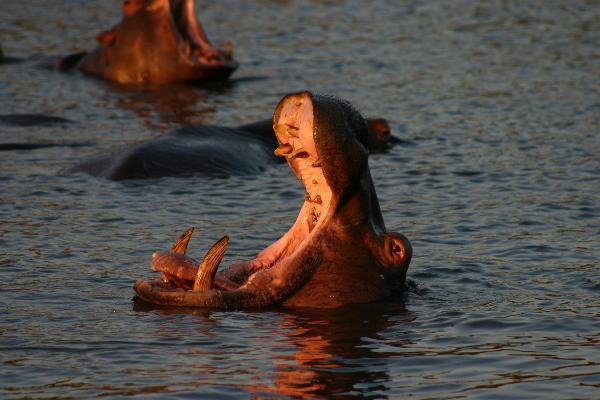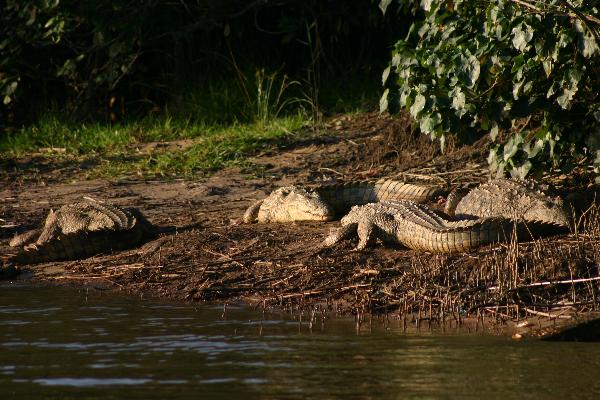The St Lucia wetlands consist of thirteen contiguous protected
areas with a total size of 234,566 hectares (the marine areas total
84,020ha.). The site is the largest estuarine system in Africa and
includes the southernmost extension of coral reefs on the
continent. The site contains a combination of on-going fluvial,
marine and wind processes that have resulted in a variety of
landforms and ecosystems. Features include wide submarine canyons,
sandy beaches, forested dune cordon and a mosaic of wetlands,
grasslands, forests, lakes and savanna. The variety of morphology
as well as major flood and storm events contribute to ongoing
evolutionary processes in the area. Natural phenomena include:
shifts from low to hyper-saline states in the Park’s lakes; large
numbers of nesting turtles on the beaches; the migration of whales,
dolphins and whale-sharks off-shore; and huge numbers of waterfowl
including large breeding colonies of pelicans, storks, herons and
terns. The Park’s location between sub-tropical and tropical Africa
as well as its coastal setting has resulted in exceptional
biodiversity including some 521 bird species.
PHYSICAL FEATURES
The Park comprises two geomorphic units: coastal plain and
continental shelf. The coastal plain is the southernmost end of the
Mozambique coastal plain. It encloses the lagoon-like lakes of one
of the major estuarine systems of Africa. These are separated from
the sea by high forested barrier dunes of wind-blown sand. To its
north-west are the low Lubombo mountains in the adjacent Mkusi Game
Reserve. The coastal geology within the site is a complex of
terrestrial and marine sediments. The uppermost, the Cretacean St
Lucia formation, is very rich in marine fossils which are exposed
on the west coasts of False Bay and Lake St Lucia. Stratified
Quaternary marine deposits related to marine transgression and
regression have resulted in a series of prominent north-south
oriented sandy dune ridges. The soils are largely infertile
wind-redistributed grey and red sands over mudstone and clay pans.
Riverbanks are alluvial.
The coastal dunes along the eastern edge of the coastal plain
are unique for the height, variety and extent of their forest
cover. Along the inter-tidal and infra-tidal coast, the coastline
has long sandy beaches between reefs of beach rock. The dunes range
between 50 and 170 meters high, the highest mapped being the
Ntambama dune (172m). They contain good deposits of ore but since
the reward of World Heritage Site Status the ore will never be
mined!
Two types of coastal lake systems have formed behind the coastal
dunes: estuarine (Lake St Lucia and Lake Kosi) and freshwater (Lake
Sibayi, Lake Bhangazi North, Lake Bhangazi South, Lake
Mgobezeleni).
The lake is supplied by five rivers, most of their catchments
lying outside the boundaries of the Park. The rivers are seasonal,
flowing during the wet summer months and reduced to isolated pools
and seepage through bed sediments in winter.
FLORA
The flora is diverse, having 152 families, 734 genera and 2173
species, approximately 9% of the flora of South Africa and 31% of
the flora of KwaZulu-Natal, have been recorded in the Park.
The wetlands of this unique estuarine system include freshwater
Phragmites australis - Cyperus papyrus swamp which covers
approximately 7000ha in the Park, forming the largest protected
wetland in South Africa; saline reed swamp on alluvium and islands
in Lake St Lucia, dominated by Phragmites mauritianus; sedge swamp,
mainly in the Mfabeni swamp.
Grassland types include hydrophilous grassland on sandy riverine
soils dominated by Acroceras macrum and Ischaemum arcuatum;
high-lying grasslands on sand.
Open woodlands include mixed Acacia/broad-leaved woodland
(Hyphaene coriacea and Ziziphus mucronata) and mixed Acacia
woodland (Acacia nigrescens, A.gerrardii, A.tortilis, A.nilotica)
which provide grazing and browsing for herbivores. Thickets of
mixed microphyllous and broad-leaved woodland subject to salt spray
and wind occur on seaward-facing dune slopes (Eugenia, Brachylaena,
Euclea, Diosporos and Mimusops species).
Forest types include swamp forest, rare in South Africa,
covering 3,095ha (64% of the South African total) dominated by
Ficus tricopoda, hygrophilous forest and Barringtonia forest. (B.
racemosa). These occur on organic soils in hypo-saline drainage
lines and marshes around freshwater lakes usually flooded with
slow-flowing water after rains; mangroves, dominated by Bruguieria
gymnorrhiza and Avicennia marina.
FAUNA
There are 97 species of terrestrial mammals in the Park
including 13 internationally threatened black rhinoceros Diceros
bicornis minor and 150 white rhinoceros Ceratotherium simum. The
Park has the largest single populations of hippopotamus
Hippopotamus amphibius (about 700) in South Africa. Populations of
bottlenose Tursiops truncatus, humpback Sousa plumbea and spinner
Stenella longirostris dolphins live in Park waters. Winter
migrations of humpback whale Megoptera novaangliae and southern
right whale Eubalaena australis can be seen.
HERPETOFAUNA
The herpetofauna is rich: 50 amphibians and 109 reptiles: and
one crocodile, 12 species of Chelonidae, 53 snakes and 42 lizards
and chameleons. The Park is the main South African breeding ground
for loggerhead Caretta caretta, and leatherback turtles Dermochelys
coriacea, with estimated populations of 2500 and 750 females
respectively. The population of Nile crocodiles Crocodylus
niloticus of approximately 1500 animals over 2m long is one of the
largest in Africa, The Park contains populations of 5 amphibians
endemic to KwaZulu-Natal, 2 being nationally threatened, and 6
internationally and 20 nationally threatened reptile species.
ICHTYOFAUNA
The ichthyofauna includes nearly 85% of the reef fish species
endemic to the west Indian Ocean region (399 species) 991 species
have been recorded. including summer aggregations of ragged-toothed
shark Tiburon odontaspis and whale shark Rhynchodon typus. The 212
estuarine species include the large Zambezi shark Carcharhinus
leucas. The fresh water fish fauna comprises 55 species including 6
internationally threatened and 16 nationally threatened species.
The Park encloses the largest estuarine prawn nursery area in South
Africa.
AVIFAUNA
The very diverse avifauna numbers 521 species which is 60% of
the South African total, approximately 200 of which are water birds
for which the Park is an important refuge. The 339 breeding species
include 23 of the 97 migrant species. There are four species
endemic to South Africa and 47 endemic or nearly endemic to the
region. The Park is an important breeding area for the pinkbacked
pelican Pelecanus rufescens, white pelican P. onocrotalus, African
fish-eagle Haliaeetus vocifer, Caspian tern Hydroprogne caspia,
goliath heron Ardea goliath.

To log the cache answer the following questions;
Geology
Is the Estuary mouth open or closed. With this in mind explain the
reason for shifts from low to hyper-saline states within the
Wetland. What would you guess the current saline state is? (Hint:
You will have to be at the published co-ordinates to know).
Fauna
Take a picture of a Family of Hippos' and Log the thier
position/location. Estimate the current Weight of the Alpha
Male.
Avifauna
Take a picture of at least three bird species found on or near the
water edge and note their full names.
Flora
Take a picture of Black and White Mangrove swamp trees and log
thier Location.
